An Assessment of the Microbiological Water Quality of Sand Dams in Southeastern Kenya
Abstract
1. Introduction
2. Materials and Methods
2.1. Field Area
- Dams built by the Africa Sand Dam Federation (ASDF) to facilitate access.
- Water table within three metres of the dam surface to ensure samples could be gathered.
- Shallow wells or scoop holes have to be used for domestic purposes.
- Dam surface not obscured by water to enable excavation when necessary.
2.2. Water Quality Indicators
2.3. Descriptions of Water Sources
2.4. Data Collection
- For a test hole, 20 L was abstracted before taking water samples.
- For a scoop hole, 20 L was abstracted or until the water became clear.
- For a covered well, the pump nozzle would be flamed with a lighter and water pumped for thirty seconds before sampling
- For covered wells, water was pumped for thirty seconds before taking water samples.
- In scoop holes, water was first scooped with a sterile cup until the water appeared clear.
2.5. Statistical Analysis Techniques
3. Results
3.1. Comparison of Sources
3.2. Comparison between Variables
3.3. Correlation between TTC and Sanitary Score
4. Discussion
4.1. Source Comparison
4.2. Sanitary Survey
4.3. Potential Risk Factors
4.4. Limitations
5. Conclusions
Author Contributions
Funding
Acknowledgments
Conflicts of Interest
References
- Rockstrom, J.; Lannerstad, M.; Falkenmarkt, M. Assessing the water challenge of a green revolution in drought prone environments. Phys. Chem. Earth 2002, 27, 949–959. [Google Scholar] [CrossRef]
- Intergovernmental Panel on Climate Change. IPCC Special Report on Managing the Risks of Extreme Events and Disasters to Advance Climate Change Adaption; Cambridge University Press: New York, NY, USA, 2012; ISBN 978-1-107-02506-6. [Google Scholar]
- Makueni County Government. Republic of Kenya Makueni County First County Integrated Development Plan; Makueni County Government: Makeuni, Kenya, 2013.
- Sunil, K. Machakos County Integrated Development Plan; Machakos Government: Machakos, Kenya, 2015.
- Hayashi, A.; Akimoto, K.; Tomoda, T.; Kii, M. Global evaluation of the effects of agriculture and water management adaptions on the water-stressed population. Mitig. Adapt. Strateg. Glob. Chang. 2012, 18, 591–618. [Google Scholar] [CrossRef]
- United Nations. Coping with Water Scarcity—Challenge of the Twenty-First Century; United Nations: New York, NY, USA, 2007. [Google Scholar]
- Lasage, R.; Aerts, J.C.C.; Verburg, P.H.H.; Sileshi, A.S. The role of small scale sand dams in securing water supply under climate change in Ethiopia. Mitig. Adapt. Strateg. Glob. Chang. 2015, 20, 317–339. [Google Scholar] [CrossRef]
- Maddrell, S.; Neal, I. Building Sand Dams: A Practical Guide; Excellent Development: London, UK, 2013. [Google Scholar]
- Ryan, C.; Elser, P. The potential for sand dams to increase the adaptive capacity of East African drylands to climate change. Reg. Environ. Chang. 2016, 16, 2087–2096. [Google Scholar] [CrossRef]
- Hut, R.; Ertsen, M.; Joeman, N.; Vergeer, N.; Winsemius, H.; van de Giesen, N. Effects of sand storage dams on groundwater levels with examples from Kenya. Phys. Chem. Earth 2008, 33, 56–66. [Google Scholar] [CrossRef]
- Quilis, R.O.O.; Hoogmoed, M.; Ertsen, M.; Foppen, J.W.W.; Hut, R.; de Vries, A. Measuring and modeling hydrological processes of sand-storage dams on different spatial scales. Phys. Chem. Earth 2009, 34, 289–298. [Google Scholar] [CrossRef]
- Ertsen, M.; Hut, R. Two waterfalls do not hear each other. Sand-storage dams, science and sustainable development in Kenya. Phys. Chem. Earth 2009, 34, 14–22. [Google Scholar] [CrossRef]
- Aerts, J.; Lasage, R.; Beets, W.; de Moel, H.; Mutiso, G.; Mutiso, S.; de Vries, A. Robustness of sand storage dams under climate change. Vadose Zone J. 2007, 6, 572–580. [Google Scholar] [CrossRef]
- Sengupta, C.; Saha, R. Understanding coliforms—A short review. Int. J. Adv. Res. 2013, 1, 16–25. [Google Scholar]
- Kitheka, J.U. Seasonal river channel water exchange and implications on salinity levels in sand dams: Case of semi-arid Kitui Region, Kenya. J. Environ. Earth Sci. 2016, 6, 66–85. [Google Scholar]
- Parker, A.H.H.; Youlten, R.; Dillon, M.; Nussbaumer, T.; Carter, R.C.; Tyrrel, S.F.F.; Webster, J. An assessment of microbiological water quality of six water source categories in north-east Uganda. J. Water Health 2010, 8, 550–560. [Google Scholar] [CrossRef] [PubMed]
- Bain, R.; Cronk, R.; Wright, J.; Yang, H.; Slaymaker, T.; Bartram, J. Fecal contamination of drinking-water in low- and middle-income countries: A systematic review and meta-analysis. PLoS Med. 2014, 11, e1001644. [Google Scholar] [CrossRef] [PubMed]
- Kostyla, C.; Bain, R.; Cronk, R.; Bartram, J. Seasonal variation of fecal contamination in drinking water sources in developing countries:A. systematic review. Sci. Total Environ. 2015, 514, 333–343. [Google Scholar] [CrossRef] [PubMed]
- Nyangito, M.; Musimba, N.; Nyariki, D. Range use and dynamics in the agropastoral system of southeastern Kenya. Afr. J. Environ. Sci. Technol. 2008, 2, 220–230. [Google Scholar]
- Gichuki, F. Makueni District Profile: Rainfall Variability, 1950–1997; Drylands Research: Somerset, UK, 2000. [Google Scholar]
- Dubrieul, X. Hydrological Processes of Artificial Aquifers in Ephemeral Rivers: Analysis of Grain Size Distribution, Porosity and Specific Yield of Sediments to Assess Potential Water Abstraction from Sand Dams. Master’s Thesis, Cranfield University, Cranfield, UK, 2017. [Google Scholar]
- RAIN. A Practical Guide to Sand Dam Implementation, Rain Foundation; RAIN: Amsterdam, The Netherlands, 2011. [Google Scholar]
- University of Surrey. OXFAM-DELAGUA, Portable Water Testing Kit (version 4.2); University of Surrey: Guildford, UK, 2004. [Google Scholar]
- Howard, G.; Pedley, S.; Barrett, M.; Nalubega, M.; Johal, K. Risk factors contributing to microbiological contamination of shallow groundwater in Kampala, Uganda. Water Res. 2003, 37, 3421–3429. [Google Scholar] [CrossRef]
- LeChevallier, M.; Evans, T.; Seidler, R. Effect of turbidity on chlorination efficiency and bacterial persistence in drinking water. Appl. Environ. Microbiol. 1981, 42, 159–167. [Google Scholar] [PubMed]
- Howard, A. Water Supply Surveillance: A Reference Manual; WEDC, Loughborough University: Loughborough, UK, 2002; ISBN 1-84380-004-7. [Google Scholar]
- World Health Organization. Guidelines for Drinking-Water Quality, 4th ed.; WHO: Geneva, Swizterland, 2011; ISBN 978-92-4-154815-1. [Google Scholar]
- Kenya Bureau of Standards. Kenya Standard (KS 05-459 PART 1:1996)—Specification for Drinking Water; KEBS: Nairobi, Kenya, 1996. [Google Scholar]
- Decker, M. Water Quality Comparison of Two Different Domestic Water Sources after Water Harvesting by Sand Dams in Rurai Areas of Makueni and Machakos Counties, Kenya. Master’s Thesis, Cranfield University, Cranfield, UK, 2016. [Google Scholar]
- World Health Organisation. Guidelines for Drinking Water Quality, 2nd ed.; WHO: Geneva, Switzerland, 1997; ISBN 92-4-154480-5. [Google Scholar]
- Avis, O. A microbial Analysis of Water Stored in Sand Dams. Master’s Thesis, London School of Hygiene and Tropical Medicine, Lodnon, UK, 2014. [Google Scholar]
- Sutton, S. Community Led Improvements of Rural Drinking Water Supplies; Knowledge and Research Project (KAR) R7128; SWL Consultants: Shrewsbury, UK, 2002. [Google Scholar]
- Onyango-Ouma, W.; Gerba, C.P. Away-from-home drinking water consumption practices and the microbiological quality of water consumed in rural western kenya. J. Water Health 2011, 9, 628–636. [Google Scholar] [CrossRef] [PubMed]
- Pritchard, M.; Mkandawire, T.; Edmondson, A.; O’Neill, J.G.G.; Kululanga. Potential of using plant extracts for purification of shallow well water in Malawi. Phys. Chem. Earth 2009, 34, 799–805. [Google Scholar] [CrossRef]
- Nabegu, A.B. Effect of sand mining on ground :water in Kano river catchement. J. Environ. Earth Sci. 2013, 3, 81–87. [Google Scholar]
- Padmalal, D.; Maya, K. Sand Mining. Environmental Impacts and Selected Case Studies; Springer: New York, NY, USA, 2014; ISBN 978-94-017-9144-1. [Google Scholar]
- Viducich, J.M.M. Spillway Staging and Selective Sediment Deposition in Sand Storage Dams. Master’s Thesis, Oregon State University, Corvallis, OR, USA, 2015. [Google Scholar]
- Jansen, J. The Influence of Sand Dams on Rainfall-Runoff Response and Water Availability in the Semi-Arid Kiindu Catchment, Kitui District, Kenya; Vrije Universiteit: Amsterdam, The Netherlands, 2007. [Google Scholar]
- Hamid, A. Studies on Salt Movement and on Tracing Water Movement in Soils; McGill University: Montreal, QC, Canada, 1966. [Google Scholar]
- World Weather Online. Weather of Eastern Kenya. Available online: https://www.worldweatheronline.com/eastern-weather/ke.aspx (accessed on 2 April 2017).
- Magrath, J. Towards Sustainable Water Supply Solutions in Rural Sierra Leone; Oxfam: Oxford, UK, 2006. [Google Scholar]
- Baxter-Potter, W.; Gilliland, M. Bacterial Pollution in Runoff from Agricultural Lands. J. Environ. Qual. 1988, 17, 27–34. [Google Scholar] [CrossRef]
- Medihala, P.G.; Lawrence, J.R.; Swerhone, G.D.; Korber, D.R. Transient response of microbial communities in a water well field to application of an impressed current. Water Res. 2013, 47, 672–682. [Google Scholar] [CrossRef] [PubMed]
- Edburg, S.; Rice, E.W.W.; Karlin, R.J.J.; Allen, M.J. Escherichia coli: The best biological drinking water indicator for public health protection. J. Appl. Microbiol. 2000, 88, 106S–116S. [Google Scholar] [CrossRef]
- Kurdryavtseva, B. An experimental approach to the establishment of zones of hygienic protection of underground water sources on the basis sanitary-bacteriological indices. J. Hyg. Epidemiol. Microbiol. Immunol. 1972, 18, 503–511. [Google Scholar]
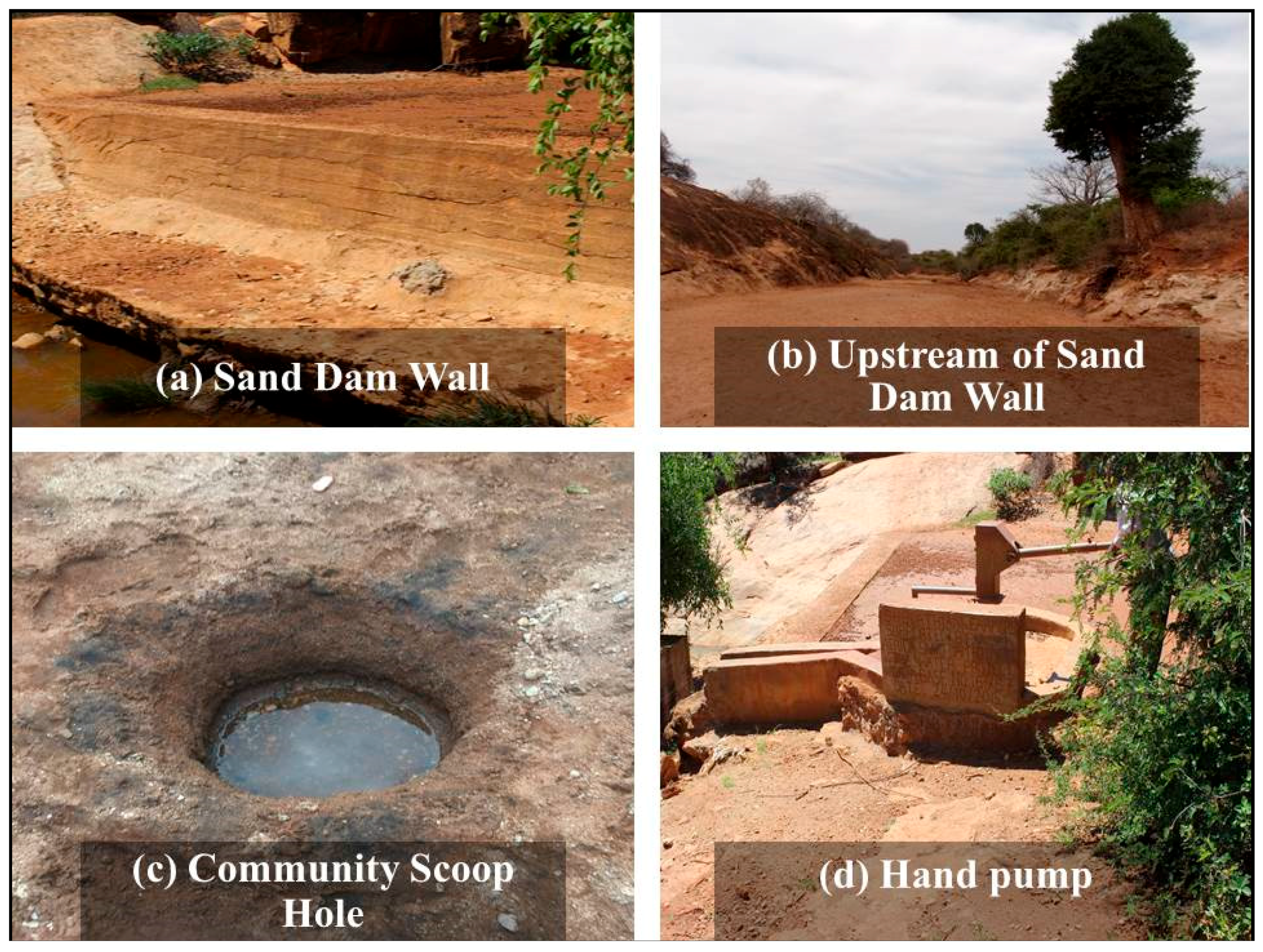
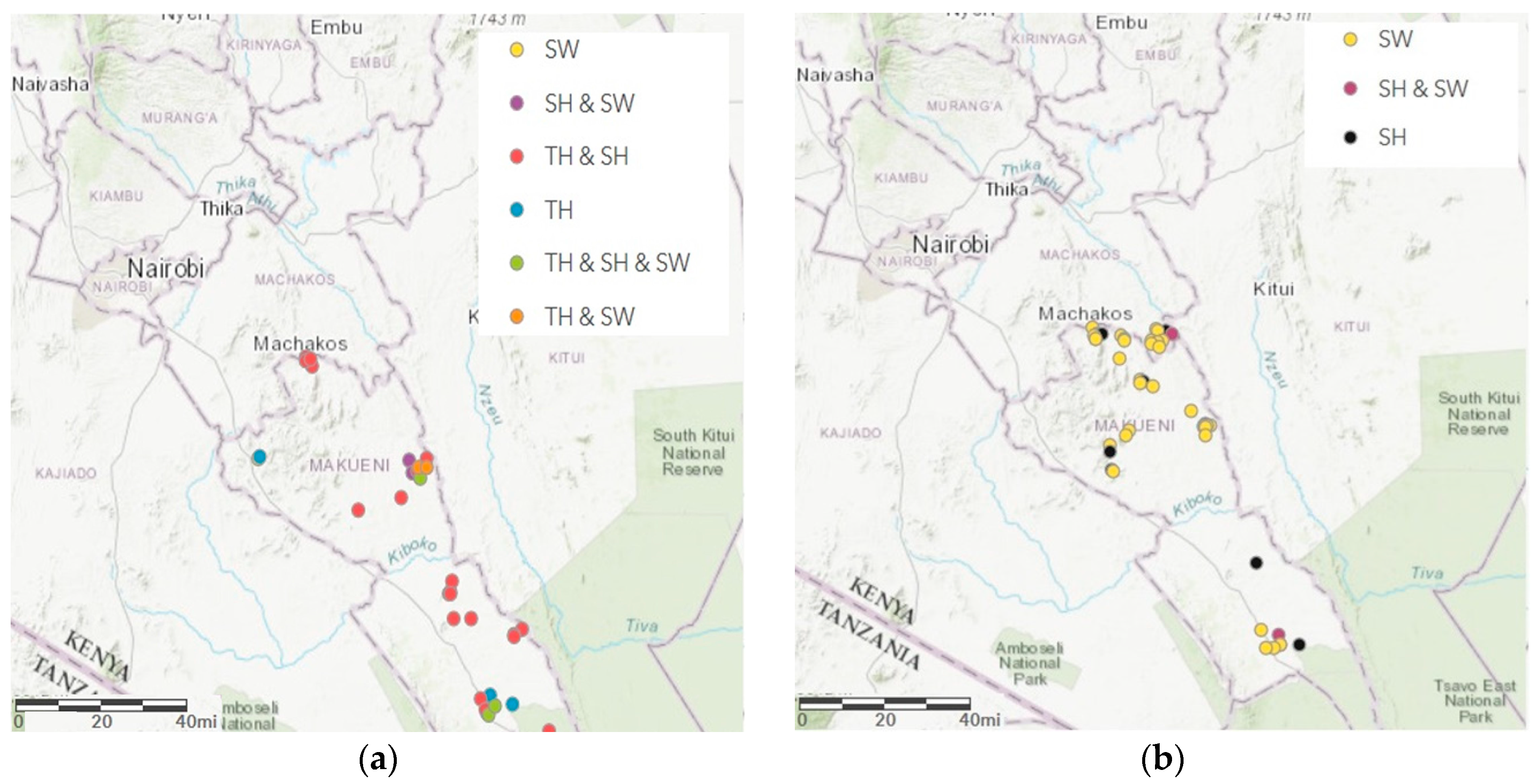
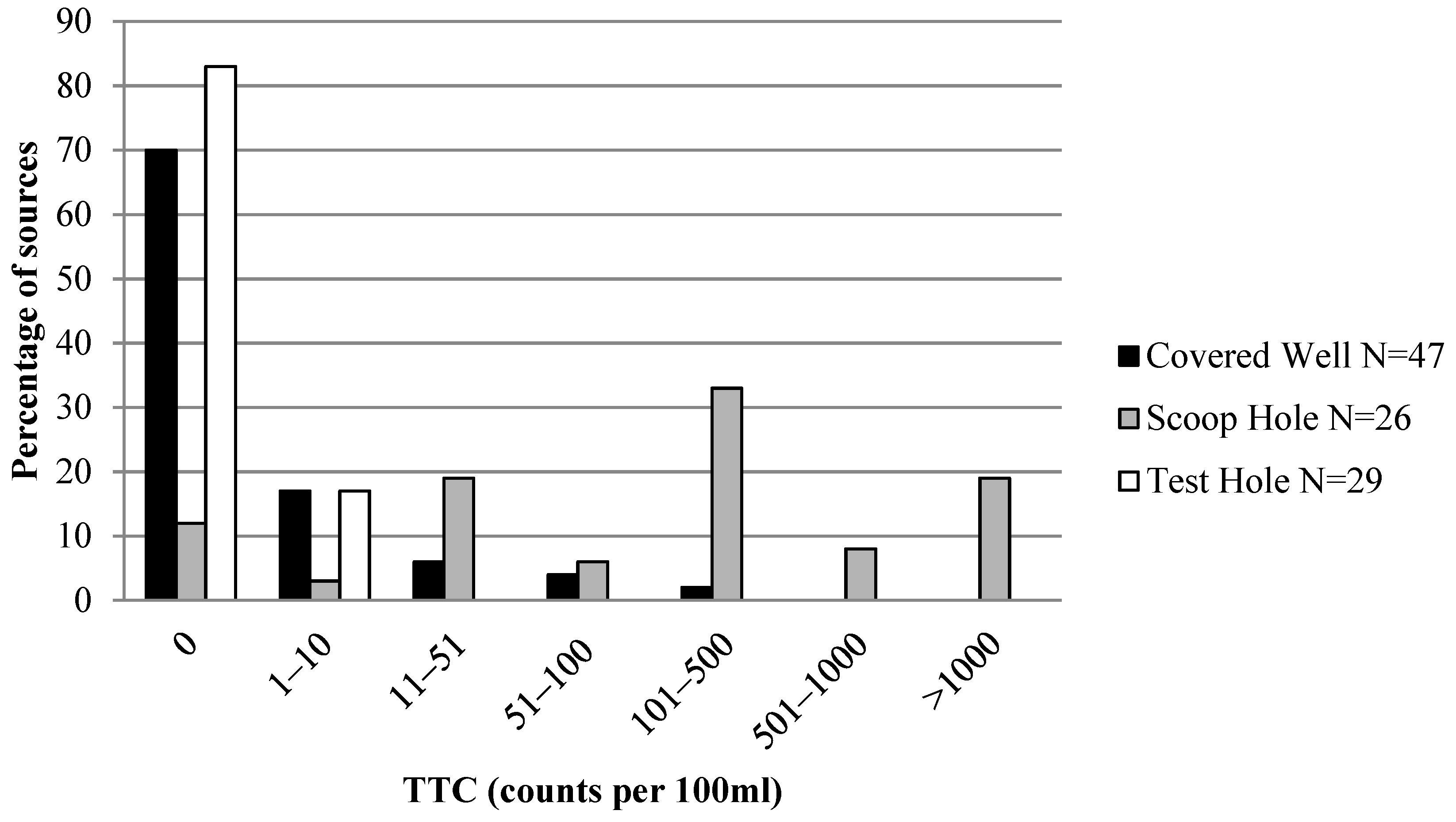
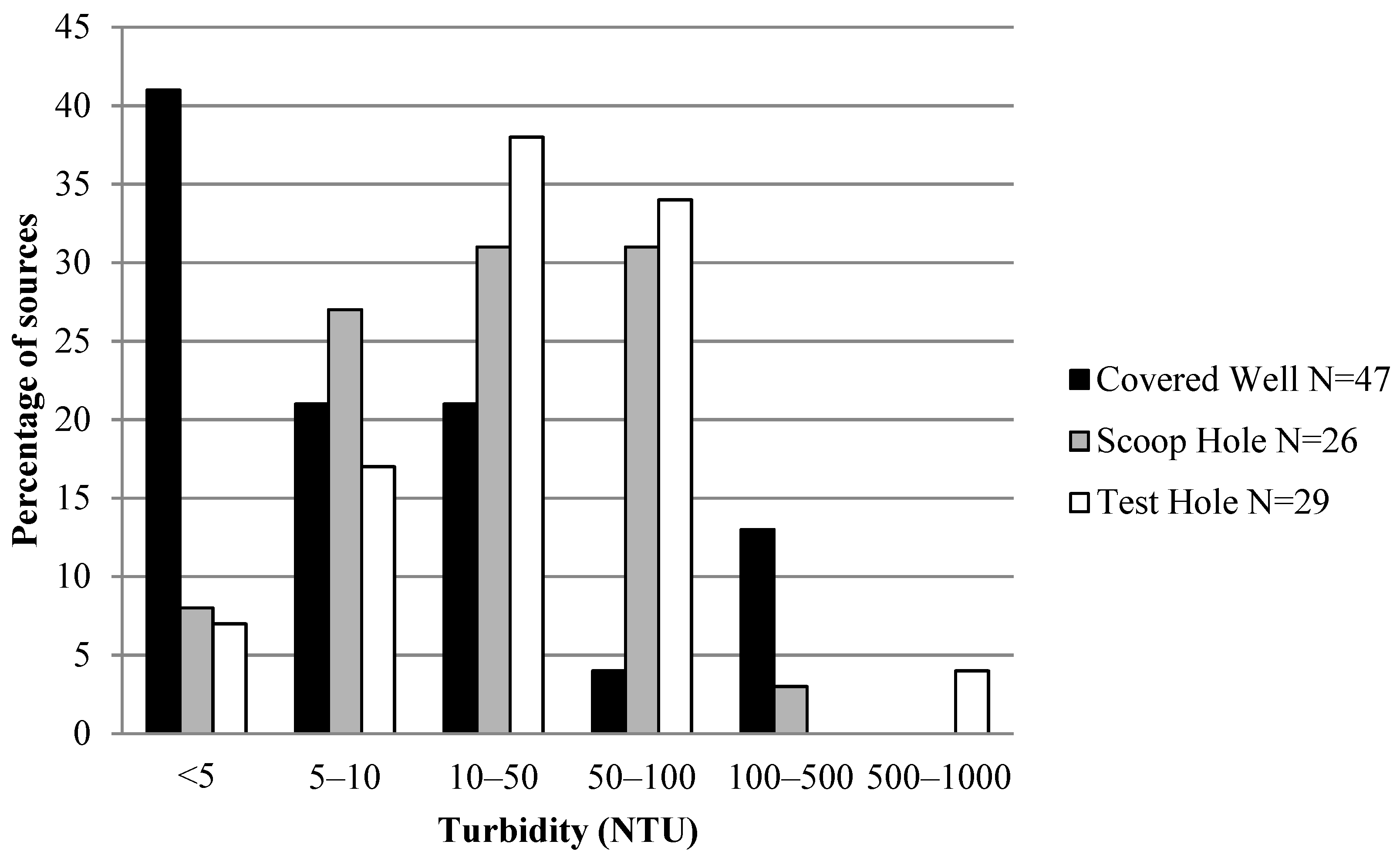
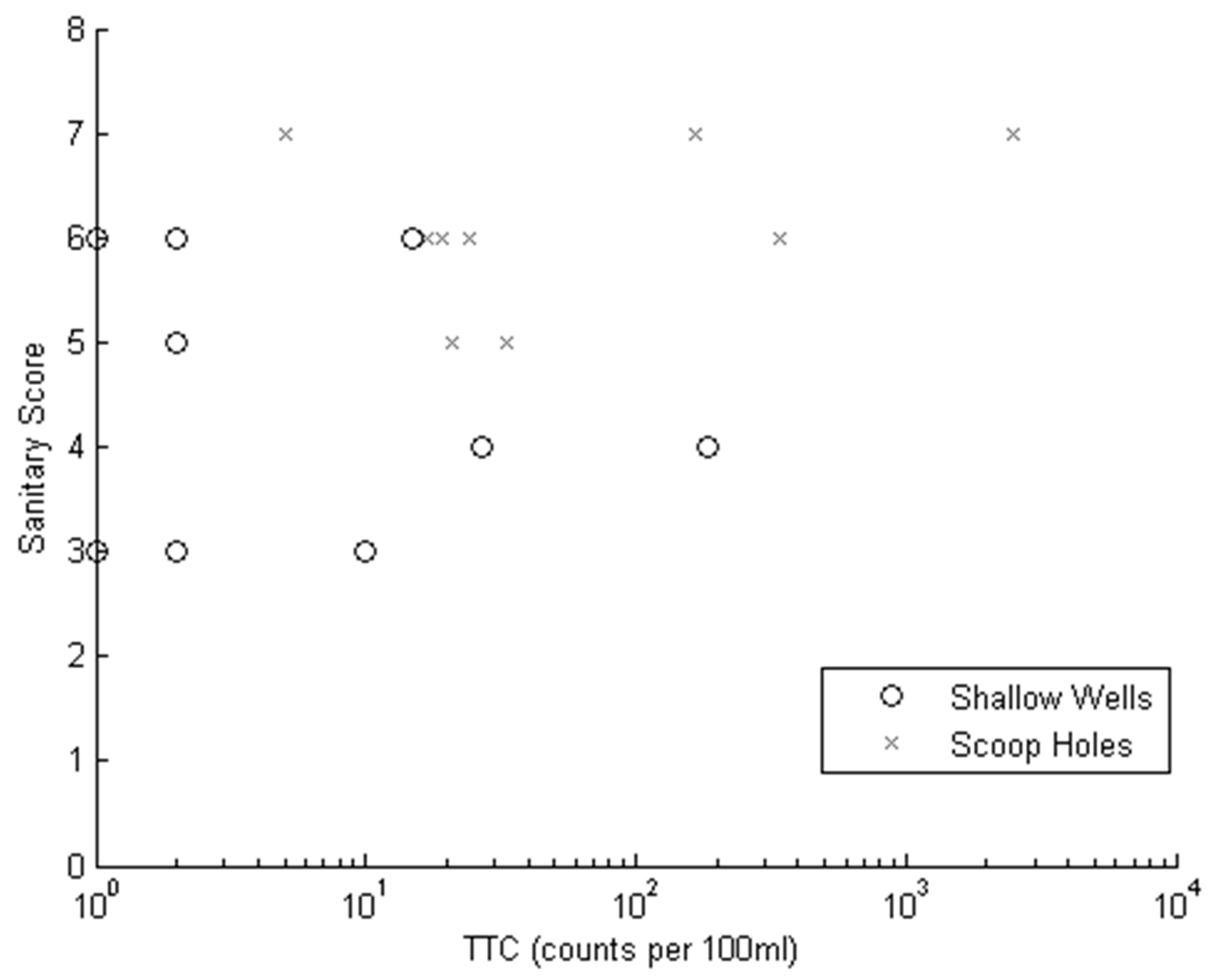
| Water Quality Indicator | KEBS [28] | WHO [27] |
|---|---|---|
| TTC (TTC/100 mL) | 0 | 0 |
| Turbidity (NTU) | <5 | <1 |
| Conductivity (µS) | N/A | 1500 |
| pH | 6.5–8.5 | 6.5–8.5 |
| Source | Number of Sources Visited | % with TTC = 0 | Percentage with Conductivity <1500 µS/cm | Median Conductivity (µS/cm) | Median TTC | Median Turbidity (NTU) | Median pH |
|---|---|---|---|---|---|---|---|
| Covered Wells | 47 | 70 (N = 33) | 74 (N = 35) | 824 (SD = 421) | 0 (SD = 0) | 5–10 (SD = 0–5) | 7.3 (SD = 0.3) |
| Scoop Holes | 36 | 11 (N = 4) | 77 (N = 28) | 912 (SD = 515) | 159 (SD = 148) | 20–30 (SD = 5–10) | 7.4 (SD = 0.23) |
| Test Holes | 29 | 83 (N = 24) | N/A | N/A | 0 (SD = 0) | 20–30 (SD = 5–10) | 7.3 (SD = 0.21) |
| Question | Percentage of “yes” Answers (N = 39) | Frequency of “yes” Answers (N = 39) | p-Value for Association between Risk Factors Identified and Presence of TTC |
|---|---|---|---|
| Is there a latrine within 10 m of the well? | 0 | 0 | n/a |
| Is there a latrine on higher ground than the well within 100 m of the well? | 10 | 4 | 0.56 |
| Is the fencing around the well inadequate to keep animals away? | 100 | 39 | n/a |
| Is the hand-pump loose at point of attachment to the well head? | 100 | 39 | n/a |
| Is the drainage channel around the well cracked, dirty, or broken? | 62 | 24 | 0.27 |
| Is the concrete apron less than one meter wide all around the well? | 54 | 21 | 1 |
| Is there poor drainage, allowing stagnant water within two meters of the well? | 100 | 39 | n/a |
| Is the concrete apron around the well cracked? | 36 | 14 | 0.70 |
| Are the walls of the well inadequately sealed? | 15 | 6 | 0.31 |
| Is there any other source of contamination within 10 m of the well? | 100 | 39 | n/a |
| Is there any farming activity within 15 m of the well? | 41 | 16 | 0.44 |
| Question | Percentage of “yes” Answers (N = 11) | Frequency of “yes” Answers (N = 11) | p-Value for Association between Risk Factors Identified and Presence of TTC |
|---|---|---|---|
| Is there a latrine within 10 m of the well? | 0 | 0 | n/a |
| Is there a latrine on higher ground than the well within 100 m of the well? | 18 | 2 | 0.48 |
| Is there any other source of contamination within 10 m of the well? | 100 | 11 | n/a |
| Is the fencing around the well inadequate to keep animals away? | 100 | 11 | n/a |
| Is the riverbed used as a road for cattle? | 100 | 11 | n/a |
| Is there a scoop hole for animal consumption upstream to the scoop hole for human consumption? | 64 | 8 | 0.49 |
| Has it rained within five days? | 0 | 0 | n/a |
| Do users have direct contact with water during the collection? | 100 | 11 | n/a |
| Is the scoop hole without any protection against runoff? | 100 | 11 | n/a |
| Is there any tree around the scoop hole which could lead to contamination? | 46 | 5 | 0.52 |
© 2018 by the authors. Licensee MDPI, Basel, Switzerland. This article is an open access article distributed under the terms and conditions of the Creative Commons Attribution (CC BY) license (http://creativecommons.org/licenses/by/4.0/).
Share and Cite
Quinn, R.; Avis, O.; Decker, M.; Parker, A.; Cairncross, S. An Assessment of the Microbiological Water Quality of Sand Dams in Southeastern Kenya. Water 2018, 10, 708. https://doi.org/10.3390/w10060708
Quinn R, Avis O, Decker M, Parker A, Cairncross S. An Assessment of the Microbiological Water Quality of Sand Dams in Southeastern Kenya. Water. 2018; 10(6):708. https://doi.org/10.3390/w10060708
Chicago/Turabian StyleQuinn, Ruth, Orlando Avis, Manon Decker, Alison Parker, and Sandy Cairncross. 2018. "An Assessment of the Microbiological Water Quality of Sand Dams in Southeastern Kenya" Water 10, no. 6: 708. https://doi.org/10.3390/w10060708
APA StyleQuinn, R., Avis, O., Decker, M., Parker, A., & Cairncross, S. (2018). An Assessment of the Microbiological Water Quality of Sand Dams in Southeastern Kenya. Water, 10(6), 708. https://doi.org/10.3390/w10060708





